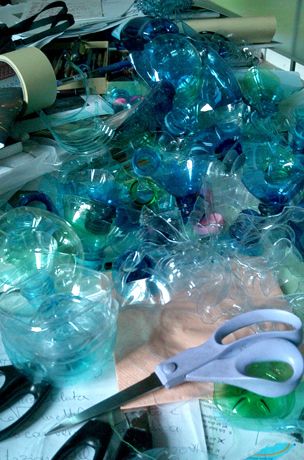Recycling materials for a sustainable approach to art
Hands-on Workshops: two experiences
In the didactic/educational itineraries followed, waste materials were considered from the point of view of their perceptive qualities, such as shape, colour, consistency and brightness. They are also analysed in both functional and structural terms. In this way, each piece of waste may be attributed a relationship of interdependence with the other materials examined.
The ability to think and re-think matter and materials is one which has always bound art and artists to their historical eras. In actual fact, all that which lies in relation to the perception of materials may offer food for thought in order to interpret and modify them with observations, actions and ideas which revisit the material from different points of view.
It is here that the problematic issues of waste materials all come to the fore: as substance, a physical entity, and also in terms of its metaphorical aspects. The artistic use of a material, one which has been cast out by a consumption-based society, gives us the scope to rethink the complexity of the notions of production/refuse and nature/artifice.
The waste products that we worked on during these workshops were plastics (polythene bags, plastic bottles and packaging). They were practical workshops, using waste materials which allowed us to reflect on waste, on how it has altered our everyday habits, lives and memories.
Art gives us the opportunity not only to transform the aesthetics of a material, but also the very value attributed to it.
Tools used included drawings, photographs, writings, web-based projects and objets trouvés, which came together to provide real and virtual spaces within which to present new narrative structures.
The objects/sculptures become condensed stories, the wandering images and figures withhold a stratified memory, in terms of the layers of waste, re-ordered through the application of poetic sense.
During the encounters, which foresee a theoretical introduction and a hands-on workshop part, the materials may be used through a range of different expressive and manual languages.
Two Case Studies
The NABA Nuova Accademia Belle Arti (Milan) and the PAV Parco Arte Vivente (Turin)
NABA Nuova Accademia Belle Arti, Milan
timetable: three days (six hours of work per day)
14/15/16 December 2009
Workshop Title: Sexy Plastic
Materials used:
Plastic really is seductive.
PET (polyvinyl chloride), used for the production of plastic bottles, may be transformed with simple, everyday objects: scissors, cutters and cigarette lighters in order to mould the plastic.
History:
Plastic bottles have been adopted for commercial purposes since 1947, but were little used until 1960, when high-density polythene was introduced. They then quickly gained in popularity thanks to their lightness and the relatively low production costs compared to glass bottles.
Observe the characteristics of the material:
- Relatively light compared to volume
- Good transparency
- Strong but flexible
- Does not rust, does not rot
- Resistant to chemical agents and bacteriological deposits
- No alteration at temperatures of 0 degrees Fahrenheit or lower
Questions raised:
Why should we throw away a material (waste) capable of setting off a new process and creating new value?
Why can’t we subjectively experiment with the possibility of making/returning to a new material?
Is the aesthetic approach capable of transforming waste?
Skills:
Good manual skills
Curiosity aroused by a practical workshop experience
The joy of play
Awareness of the reuse of waste materials
Tools used:
Transparent and coloured plastic bottles, cutters, scissors, pins, protective masks.
PAV, Parco Arte Vivente, Turin
timetable: one day (7 hours)
11 December 2010
Title: Exploring a sea of grass on recycled ships
Aim: To open new routes through the park by building load-bearing platforms created through the use of waste materials.
Endowed with eco-friendly floating ‘rafts’, we will be ready to set sail across the seas of grass (and water and earth and stones) in the park.
Materials:
Plastic bottles, bags, Tetrapak cartons and all the usual waste products from commercial packaging.
Tools used:
Transparent and coloured plastic bottles, polythene bags, cutters, scissors, protective masks.
